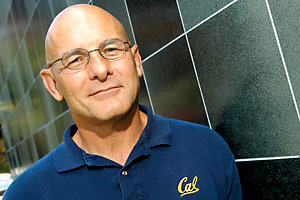David A. Patterson facts for kids
Quick facts for kids
David Patterson
|
|
|---|---|
 |
|
| Born | November 16, 1947 |
| Nationality | American |
| Alma mater | UCLA |
| Known for | RISC RAID Network of Workstations |
| Awards | Eckert–Mauchly Award (2008) ACM Distinguished Service Award (2007) Computer History Museum Fellow (2007) National Academy of Engineering Member National Academy of Sciences Member AAAS Fellow ACM Fellow (1994) IEEE Fellow Karl Karlstrom Outstanding Educator Award (1991) |
| Scientific career | |
| Institutions | University of California, Berkeley |
| Thesis | Verification of Microprograms (1976) |
| Doctoral advisor | David F. Martin Gerald Estrin |
| Doctoral students | Garth A. Gibson David Ungar |
David Andrew Patterson (born November 16, 1947) is an American computer expert and professor. He has been a Professor of Computer Science at the University of California, Berkeley since 1976. He is famous for helping to create important ideas in computer design, like RISC processors and RAID storage systems.
What is David Patterson Known For?
David Patterson has made big contributions to how computers work. He helped develop ideas that make computers faster and more reliable. His work has influenced almost every computer you use today, from your phone to huge data centers.
RISC: Making Computers Faster
One of David Patterson's most important ideas is the RISC (Reduced Instruction Set Computer).
How Computers Understand Commands
Think of a computer's brain, the CPU, as someone who follows instructions. These instructions are called "instruction sets." Older computers had very complex instruction sets. This meant the CPU had to do a lot of work to understand each command.
The RISC Idea
Patterson and his team realized that if they made the instruction set simpler, the CPU could work much faster. Imagine giving someone simple, clear steps instead of long, confusing ones. That's what RISC does. It uses fewer, simpler instructions. This makes the CPU design easier and allows it to process commands very quickly.
Impact of RISC
Today, RISC architecture is used in many devices. It's in your smartphone, tablet, and many other portable gadgets. It helps them run fast while using less power.
RAID: Keeping Your Data Safe
Another big idea from David Patterson is RAID (Redundant Array of Independent Disks).
The Problem with Single Hard Drives
Imagine you have all your important files on one computer hard drive. What happens if that drive breaks? All your files could be lost! Also, a single hard drive can only read and write data so fast.
How RAID Works
RAID solves these problems by using several hard drives together. "Redundant" means there's a backup. If one drive fails, your data is safe on the others. "Independent Disks" means they work separately but also together.
Benefits of RAID
- Data Safety: If one drive breaks, your data is still available on the other drives.
- Faster Performance: Data can be spread across multiple drives. This allows the computer to read and write information much quicker.
- More Storage: You can combine the space of many drives into one large storage area.
RAID is super important for big companies and websites. It helps keep their data safe and available all the time.
Network of Workstations (NOW): Powerful Computing
David Patterson also worked on the idea of a Network of Workstations (NOW). This is a type of computer cluster.
Using Many Computers Together
Imagine you have a really big math problem to solve. Instead of using one super-powerful computer, what if you could link many regular computers together? That's the idea behind NOW. It connects many separate computers (workstations) to work on one big task.
How NOW Helps
- Cost-Effective: It's often cheaper to link many regular computers than to buy one giant supercomputer.
- Scalability: You can easily add more computers to the network as you need more power.
- Solving Big Problems: NOW systems are used for complex tasks. These include weather forecasting, scientific research, and creating special effects for movies.
This idea helped lead to modern cloud computing and large data centers. These systems use thousands of computers working together to power the internet.
Awards and Recognition
David Patterson has received many awards for his amazing work. These awards show how much his ideas have changed the world of computers. Some of his awards include:
- Eckert–Mauchly Award (2008)
- ACM Distinguished Service Award (2007)
- Computer History Museum Fellow (2007)
He is also a member of important groups like the National Academy of Engineering and the National Academy of Sciences. This means he is recognized as one of the top experts in his field.

